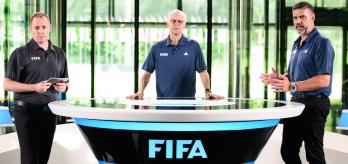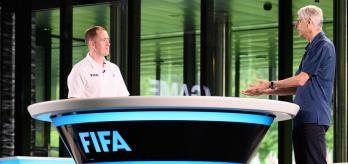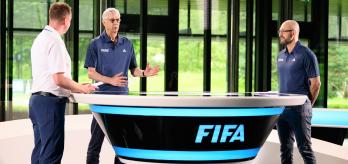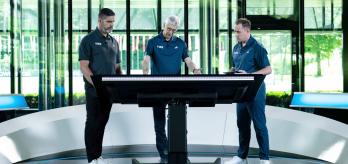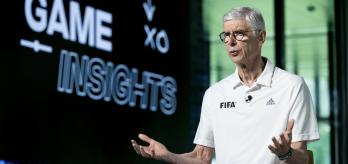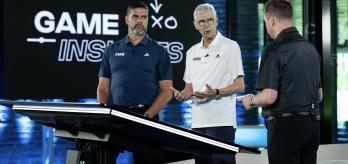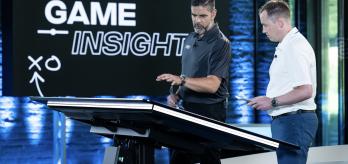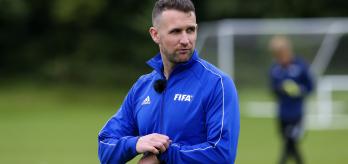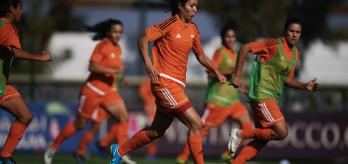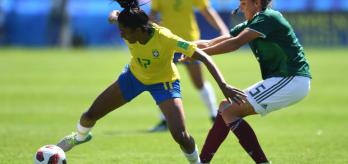In this episode of Game Insights, Chris Loxston, Group Leader Football Performance Analysis & Insights, is joined by Chief of Global Football Development, Arsène Wenger, to analyse Qatar’s devastating first-half performance in their FIFA Arab Cup™ quarter-final against the United Arab Emirates, which saw the hosts race into a 5-0 half-time lead, despite only recording around 24% of possession. After outlining the basic principles of a high press, Wenger goes on to explain how Qatar disrupted the UAE’s possession-based game and the crucial role played by their strikers and central midfielders within this system. The episode concludes with a look ahead to the FIFA World Cup™ as we consider how the hosts might adapt their high press when performing on the global stage.
Part 1: Introduction to the high press
01:56
Basic principles of a high press
If you want your team to play a high press, all your players (including your strikers) have to be fit enough to press for a full 90 minutes, and prepared to make the effort that involves. They also need to be mentally alert and focused on getting back into their defensive positions as quickly as possible.
04:05
Pressing and pushing on
Pressing is all about applying pressure on the player on the ball so that they no longer have the freedom to decide what to do with it and influencing their decision making. When a team is described as “pushing on”, this means that they press opposition players who do not have the ball to make sure they are not available to receive a pass. Teams that decide to push on need to do so collectively and at speed to reduce the passing options available to the player in possession.
05:15
Qatar opt to press in final third
“They decided, ‘Look, [the UAE] want to have the ball, they want to build up from the back, and we have to stop that. We will go higher up’ – and that’s what we call a high press. From the start of the build-up onwards, you want to win the ball back.” (AW)
Part 2: QATAR’S GAME PLAN
00:24
Game plan
The UAE wanted to play possession-based football, rather than focusing on getting the ball forward quickly. To stop them, Qatar decided to press them hard to prevent them from having any time on the ball, and they achieved this very effectively. The way the Qatari press was organised was indicative of a team that has spent long periods of time together, and was more reminiscent of a well-drilled club side than a national team.
01:13
Qatar's opening goal
The Qataris’ strategy requires the wing-backs to press the player in possession when the ball is played out wide. Here, though, the central midfielder instructs the right wing-back to drop back into the defensive line. As the right-back retreats into the back five, the central midfielder comes out to mark the UAE’s left-back. Meanwhile, Qatar’s right-sided striker stops the UAE’s left-back from playing the ball, before immediately going to press the centre-back. The defender then slips, which eventually leads to the opening goal
06:46
Total focus
“We can see that all ten outfield players are permanently switched on – the defenders, the midfielders and the strikers. And there is not one moment where one of the players is not completely focused. I think that is a characteristic of the modern game – it demands full concentration for 90 minutes, especially if you want to apply the quality of that press.” (AW)
08:00
Qatar's second goal
Here we see the left wing-back move out of the defensive line to create the press. The key to the goal is the way Qatar move the ball forward as soon as they regain possession. For a high press to be dangerous, the first pass after the ball has been won back should be forward; otherwise, the opposition have the time to regroup and recover their shape.
Part 3: HOW THE PRESS IS ORGANISED
00:30
Sprinting to the press
“When you play football and you have the ball, you always assessthe desire of your opponent. And you know that when they sprint towards you, you do not have much time to make a decision. So it creates some insecurity and they do that well – they sprint.” (AW).
01:50
Risks involved in the press
Pressing towards the ball inevitably means leaving space somewhere else on the pitch. In this example, Qatar’s defence sits slightly too deep, which leaves them vulnerable to a 2v1 situation. Fortunately for Qatar, their pressure on the player in possession is effective and the UAE are unable to play in behind. This in turn allows the Qatari defence to push up to reduce the distance between the lines.
05:55
How to react when the opposition beat the press
Here, the UAE play through the press and Qatar set up in a mid-block. Qatar get back into their structure very quickly, win the ball, and immediately play it forward to create a goalscoring opportunity for Almoez Ali. The risk of this mid-block is that the wide players are left free, but in this example, Qatar still have the option of sending a defender out to nullify any threat in wide areas.
07:35
Anticipation
Elite players are capable of reading body positions to anticipate the direction of the next pass. This is a vital element within a good press; midfielders need to be able to anticipate where the ball is going and move out to meet it immediately, providing no respite for the opposition.
09:12
Role of the midfield trio
As the ball moves across the pitch, the midfielders have to shift across with it, leaving the other side of the pitch completely open. Midfielders who operate in this system must have high levels of stamina, great focus, and the ability to read the game and win the ball back.
10:45
How to combat the press
One way of playing against Qatar’s system would be to set up with two wingers to stop the Qatari wing-backs from moving up to support the midfielders. This would leave the three midfielders to cover the full width of the pitch by themselves. The UAE actually use this tactic in this sequence, but ultimately fail to take advantage of the space it created for them, which could have generated a 3v3 attacking situation. It is important that the midfielders receive the support of the wing-backs, given that without their help, they would simply be left with too much ground to cover.
12:17
Role of the strikers
“You can see that Almoez is completely focused on doing this job very well. If the two strikers don’t press, you are dead. If one of the two strikers doesn’t do it, you are dead as well. You need absolutely everybody to be switched on permanently. What they do well here is when they can’t win the ball, they come close to their midfielders again.” (AW)
Part 4: TRIGGERS AND METRICS
00:08
Roles and responsibilities
“Normally the press starts with the strikers. They orient themselves to the game of the opponent. Usually the trigger is when the ball goes wide. When the ball goes wide, you have to stop the game and stop the opponent from switching sides, so your two strikers need to block the centre-backs.” (AW)
00:55
Importance of “team length”
“Team length” measures the distance between a side’s deepest defender and highest attacker. At the FIFA Arab Cup, the most compact teams ended up making it through to the latter stages. This is not surprising given that it is easier to win the ball back if your lines are short, and because a compact shape also means your players have less ground to cover.
01:52
Will Qatar be able to apply this press at the FIFA World Cup?
Qatar are very well drilled, focused, and remarkably well organised. However, there are still question marks as to whether they will be able to press world-class opposition as effectively, and sustain it throughout the whole tournament. If they feel they do not have 20 players who are capable of doing so, they may choose to set up in a lower block against “bigger” teams and look to play on the counter-attack.
Part 5: LOOKING AHEAD TO THE FIFA WORLD CUP
00:10
Importance of coaching
“This [whether they press against the “big” teams at the World Cup] is for the expertise of the staff to decide, and then to convince the players. If you tell them ‘We are playing Brazil tomorrow and we will press high up,’ first you have to convince the players that it will work, because they look at each other and ask ‘Are you sure we can do that?’”.(AW)







